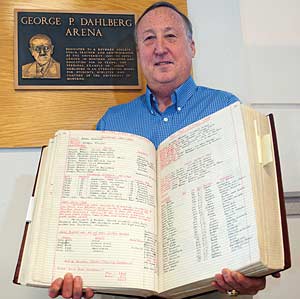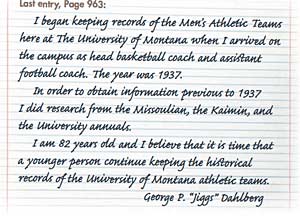

The Magazine of The University of Montana
Artifacts
by John Heaney Photos by Todd Goodrich

Dave Guffey displays the Red Book near a plaque commemorating George P. “Jiggs” Dahlberg, who wrote the book, in the Adams Center at UM.
It’s either serendipity or dumb luck. You decide.
But while I was thumbing through the massive Red Book, a handwritten history of UM athletics from 1897 to 1980, I randomly stopped on page 222, which covers the 1938 football team.
As I read the roster, I came across a name that gave me goose bumps: “Edward Hudacek, 5’8”, halfback, Wheeling, West Virginia.”
“Uh, Guff,” I said to Dave Guffey, longtime sports information director at UM, “I just found my great uncle in here. I had no idea he played football for the Griz.”
“Cool!” Guffey replied with a chuckle. “I told you that book was amazing.”
Amazing is an understatement.
The Red Book was penned, literally, by Butte’s own George P. “Jiggs” Dahlberg, a former athlete, coach, and athletic director at UM. He’s the all-time winningest men’s basketball coach in school history, and the arena in the Adams Center is named in his honor. Dahlberg died in 1993, and Guffey brought the Red Book to the funeral service and spoke of its significance.
It’s called the Red Book because the color of the original cover was, you guessed it, red. The book was re-bound a few years ago, and now the cover is more of a maroon hue, but it’s still referred to as the Red Book.
And it’s large. The book has 1,551 hand-numbered pages—963 of which are filled with stats from each sport played at the University over a span of eighty-three years. Some pages are worn, smeared, or yellow-tinged, but the book, which weighs more than thirty pounds, is in remarkably good shape.
Pages 964 through 1,406 are blank, while a record of awards and accolades begins on page 1,407. In Dahlberg’s last entry on page 963, he writes that it’s time for someone younger to take over updating the Red Book.

But Guffey, who started working at UM in 1978, was tentative to write in it.
“I haven’t touched it,” he says. “Honestly, I don’t feel like I should. It’s all Jiggs Dahlberg’s work.”
Starting with the 1897-98 football entry, each sport’s team roster, schedule, results, letterwinners—basically any statistic you could want—are neatly written, some cursive, some printed, in black ink. The headings are red ink, giving it a nice contrast and appealing aesthetic.
The book’s home is on a shelf in Guffey’s office, and he says he still refers to it at least weekly, if not more often.
“In my opinion, the Red Book is priceless,” Guffey says. “It makes me nervous just to have the original in here. It probably should be under glass in the library. But I take extremely good care of it, and rarely does it leave my office.”
The content of the book is incredible.
Want to know who the biggest guy on that 1897 football team was? The Red Book will tell you it’s Howard Goodfellow, a center out of Ovando who weighed in at a whopping 200 pounds.
Want to know who coached Montana’s first Big Sky Conference champion varsity ski team? Or when the team won it? The Red Book knows the answers. It was Matthew “Rusty” Lyons, and the year was 1970.
“It’s got swimming, baseball, wrestling, women’s gymnastics,” Guffey says. “He didn’t leave any sports out. If it was going on, it’s in there. It would take a huge amount of research to find that stuff out now. And it’s all right there, in the Red Book.”
Of course, there is an updated record-keeping system in place now, Guffey says. And the Red Book has been transcribed into a digital copy over the years.
When asked about the importance of the Red Book to UM, Guffey struggles to come up with the right words.
“Man,” Guffey says, thinking. “It’s the primary source for sports information and the history of Grizzly Athletics. It just is. I don’t know what I’d do without it. I really don’t.”

 Email Article
Email Article 